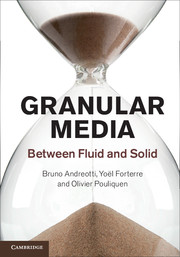4 - The granular solid: plasticity
Published online by Cambridge University Press: 05 June 2013
Summary
In the previous chapter, we discussed the statics and the elasticity of granular media, when deformations are small and reversible. In this chapter, we address the plasticity of granular media, i.e. irreversible deformations occurring beyond the elastic regime. The two issues associated with plasticity are the following: what is the maximum stress level a granular medium can sustain before being irreversibly deformed and how does the deformation take place beyond the threshold? These questions are covered by soil mechanics, which aims to predict and understand soil stability in nature or during construction in civil engineering. The approaches are mainly based on macroscopic and phenomenological models derived from continuum mechanics. More recently, physicists have been interested in the plasticity of disordered materials, focusing on the microscopic features and trying to understand how rearrangements occur at the grain scale. The link with the continuum models proposed in soil mechanics is still a challenge. In this chapter we will focus on simple macroscopic continuum models, and will only briefly discuss the microscopic properties in a box. The first section (Section 4.1) is dedicated to the phenomenology of plasticity. Several configurations that are used for studying the deformation of a granular medium are described. Section 4.2 is dedicated to the plane shear configuration, for which all the properties of the plasticity of granular media can be introduced using scalar quantities. Tensors, which are necessary to model plasticity, are introduced in Section 4.3. The Mohr–Coulomb model is described and Mohr’s circle used to represent the stress tensor is introduced. In Sections 4.4 and 4.5, we discuss briefly more complex models and unresolved questions. Finally, the plasticity of cohesive materials is presented in Section 4.6.
- Type
- Chapter
- Information
- Granular MediaBetween Fluid and Solid, pp. 122 - 168Publisher: Cambridge University PressPrint publication year: 2013



